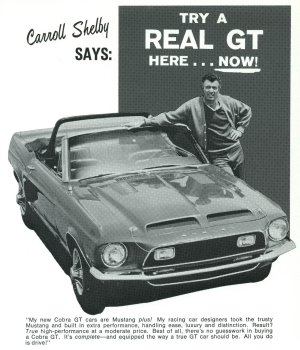Lyndon B. Johnson was president, the Beach Boys released their best-selling album
and Carroll Shelby was focused on sending Ferrari home from
Le Mans without a trophy. It was the summer
of 1966, and after two years of selling their Mustang-based G.T. 350 Fastback,
Shelby American unveiled their plan for the upcoming
1967 model year. It included:
1) Offering the
venerable
8-cylinder big block 428 cu.in. FE-series "Ford Cobra"
8V engine in addition to the proven 289 cu.in. 4V
hi-po engine;
2) Augmenting the
car's body with fiberglass components to give the Shelby G.T. a
race-inspired aggressive stance with distinct styling from the
Mustang upon which it was based;
3) Introducing
coupe and convertible body styles
as 1967½ models (mid-year).
Long-term plans
also included developing a Shelby Cougar
XR-7S for 1968.
This
plan was put into
motion on August
8th, 1966, when Shelby American began placing orders
for 1967 model year cars with Ford
Motor Company.
In the first three days of placing
orders, a total of 111 cars were
requisitioned
-- there was one G.T. 500 coupe, one G.T. 500 convertible
and the rest were a mix of G.T. 350 and G.T. 500 fastbacks.
Unfortunately, as
soon as Shelby attempted to fit their pre-ordered supply of fiberglass components to the first batch of cars
delivered by Ford's San Jose assembly plant in early October, the
operation was plagued with fitment, quality control, supply chain
and financial problems. These "launch problems"
prevented Shelby from being able to finish cars resulting in Ford's
immediate intervention. FoMoCo's Dr. Ray Geddes took over
operations and ordering who then called upon Fred Goodell to
move from Dearborn to Los Angeles and assume the role of Chief Engineer.
After identifying the source of the production problems, Ford
called on A.O. Smith Plastics in Ionia, MI to help solve the
critical issues related to the design, fabrication and fitment
of the fiberglass components.
Throughout October, Shelby
American managed to complete approximately a hundred cars --
all were G.T. 350 cars. In November,
the first big block G.T. 500 cars, including the coupe,
convertible and fastback
were completed by Ford's San Jose assembly plant.
This trio became the first
dual-quad 428 cu.in. Mustangs
built by Ford and subsequently the first big block G.T. cars
delivered to, completed by and serialized (0100, 0131 and
0139) by Shelby American, Inc.
All three were designated "company cars,"
assigned to the engineering department and
fitted with the same '67 livery as all December '66 built G.T. cars (fiberglass
hood, one-piece
front-end, one-piece grille, inboard high-beams, modified rear valance,
Cougar tail lights, exhaust
tips, emblems & stripes).
Though Carroll Shelby
stated that the convertible was his "personal driver,"
subsequent interviews
with former employees indicate "the convertible was
being driven by one of the
gals who worked in the upstairs executive offices at the LAX facility."
Quality issues and
production problems,
primarily caused by the cars' hastily designed fiberglass modifications,
continued to plaque the operation. Shelby's last fulfilled
orders were placed in March 1967 and the original plan to
offer 1967½
convertibles was scrubbed. This decision ultimately resulted
in the first '67 G.T. 500 convertible (0139) built becoming the only
'67 G.T. convertible ever built, and the first '67 G.T.
coupe (0131 - "Little Red") becoming the only '67 G.T.
500 coupe ever built.
As history has now revealed, Shelby's aggressive plan to grow from a
single G.T.
350 model in 1966 to six different models by 1968 proved to be too much
for the small California company...
 With FoMoCo's updated
"function before form" design of the '68 model, A.O. Smith
fabricated
and shipped two sets of redesigned hoods, front-ends, tail light panels
and consoles to California. In April 1967, Shelby American
was tasked with installing the components on two cars, a
fastback and a convertible. The updated cars would be used
for advertising ("photographic") purposes. Several hundred
photographs were taken multiple scenic Southern California locations,
including Malibu Beach, Hollywood Park and the mountains of Idyllwild. With FoMoCo's updated
"function before form" design of the '68 model, A.O. Smith
fabricated
and shipped two sets of redesigned hoods, front-ends, tail light panels
and consoles to California. In April 1967, Shelby American
was tasked with installing the components on two cars, a
fastback and a convertible. The updated cars would be used
for advertising ("photographic") purposes. Several hundred
photographs were taken multiple scenic Southern California locations,
including Malibu Beach, Hollywood Park and the mountains of Idyllwild.
Circa April 1967,
about six
months after Ford first intervened, the
decision to terminate the California-based Shelby
Program was made. In August 1967, Shelby American, Inc.'s assets, including the
engineering cars,
were shipped to Ford's headquarters in Dearborn, MI.
In October 1967, the photos previously taken of the
disguised convertible and fastback made their way to printed
brochures, magazine ads and dealer
literature that was used for the promotion of the upcoming 1968 model year
Shelby Cobra G.T. cars.
Once in Michigan,
#0139 was updated with regular production fiberglass. Internal documents
indicate the convertible was assigned to Ray Geddes - Marketing Department with the label "Oil
Company Promotion." The car served
this purpose through at least through October 31, 1968. Once the '69 models were
available, there'd no longer be a need for any '68s for
marketing and the convertible would have likely been
sold-off as a used car, either through the Ford corporate
B-lot or through a dealer.
After several years
of researching and documenting this convertible's special history,
Jason Billups was entrusted to perform the Concours-level
restoration
with the priceless technical
contributions from many experts, enthusiasts and past
employees in the Shelby community.
Today, the convertible
has been restored to its "earliest point as a Shelby" and
wears 1967 Shelby styling and upgrades, just as she did in
December of 1966 when
the legendary Carroll Shelby first took the wheel of this
multi-carbureted big-block
drop-top.
|